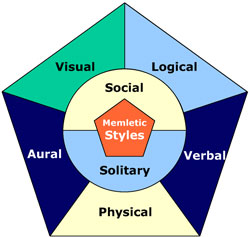|
|
Overview of Learning Styles
Many people recognize that each person prefers different learning styles and techniques. Learning styles group common ways that people learn. Everyone has a mix of learning styles. Some people may find that they have a dominant style of learning, with far less use of the other styles. Others may find that they use different styles in different circumstances. There is no right mix. Nor are your styles fixed. You can develop ability in less dominant styles, as well as further develop styles that you already use well. Many people recognize that each person prefers different learning styles and techniques. Learning styles group common ways that people learn. Everyone has a mix of learning styles. Some people may find that they have a dominant style of learning, with far less use of the other styles. Others may find that they use different styles in different circumstances. There is no right mix. Nor are your styles fixed. You can develop ability in less dominant styles, as well as further develop styles that you already use well. Using multiple learning styles and �multiple intelligences� for learning is a relatively new approach. This approach is one that educators have only recently started to recognize. Traditional schooling used (and continues to use) mainly linguistic and logical teaching methods. It also uses a limited range of learning and teaching techniques. Many schools still rely on classroom and book-based teaching, much repetition, and pressured exams for reinforcement and review. A result is that we often label those who use these learning styles and techniques as �bright.� Those who use less favored learning styles often find themselves in lower classes, with various not-so-complimentary labels and sometimes lower quality teaching. This can create positive and negative spirals that reinforce the belief that one is "smart" or "dumb". By recognizing and understanding your own learning styles, you can use techniques better suited to you. This improves the speed and quality of your learning. The Seven Learning Styles
Why Learning Styles? Understand the basis of learning stylesYour learning styles have more influence than you may realize. Your preferred styles guide the way you learn. They also change the way you internally represent experiences, the way you recall information, and even the words you choose. We explore more of these features in this chapter. Research shows us that each learning style uses different parts of the brain. By involving more of the brain during learning, we remember more of what we learn. Researchers using brain-imaging technologies have been able to find out the key areas of the brain responsible for each learning style. For example:
Where to next?Click the links in the navigation menu on the left (or above) to learn more about the individual learning styles, or go to the learning styles inventory page to try a test to discover your own learning styles. |
© Advanogy.com 2025 - All rights reserved.
